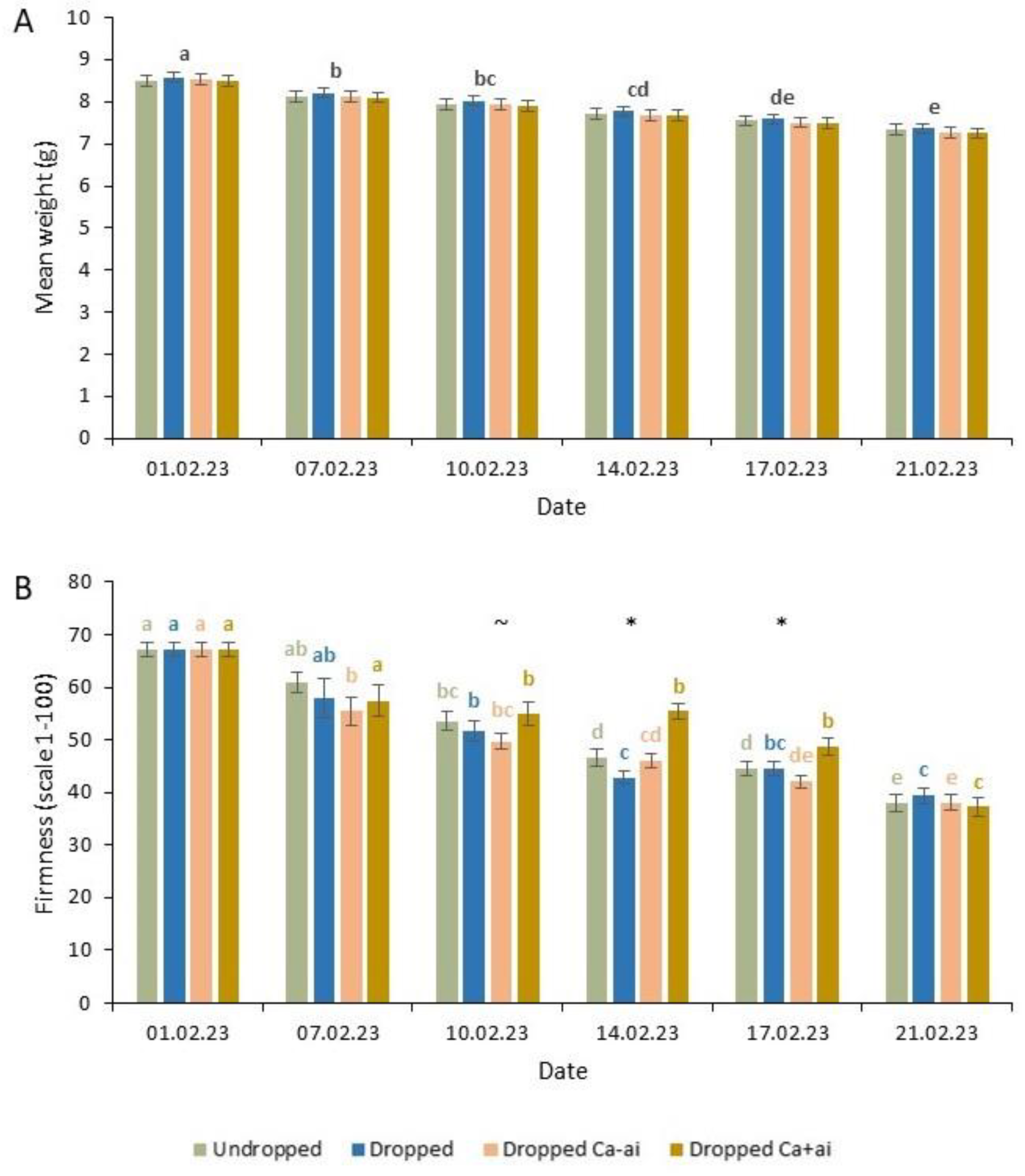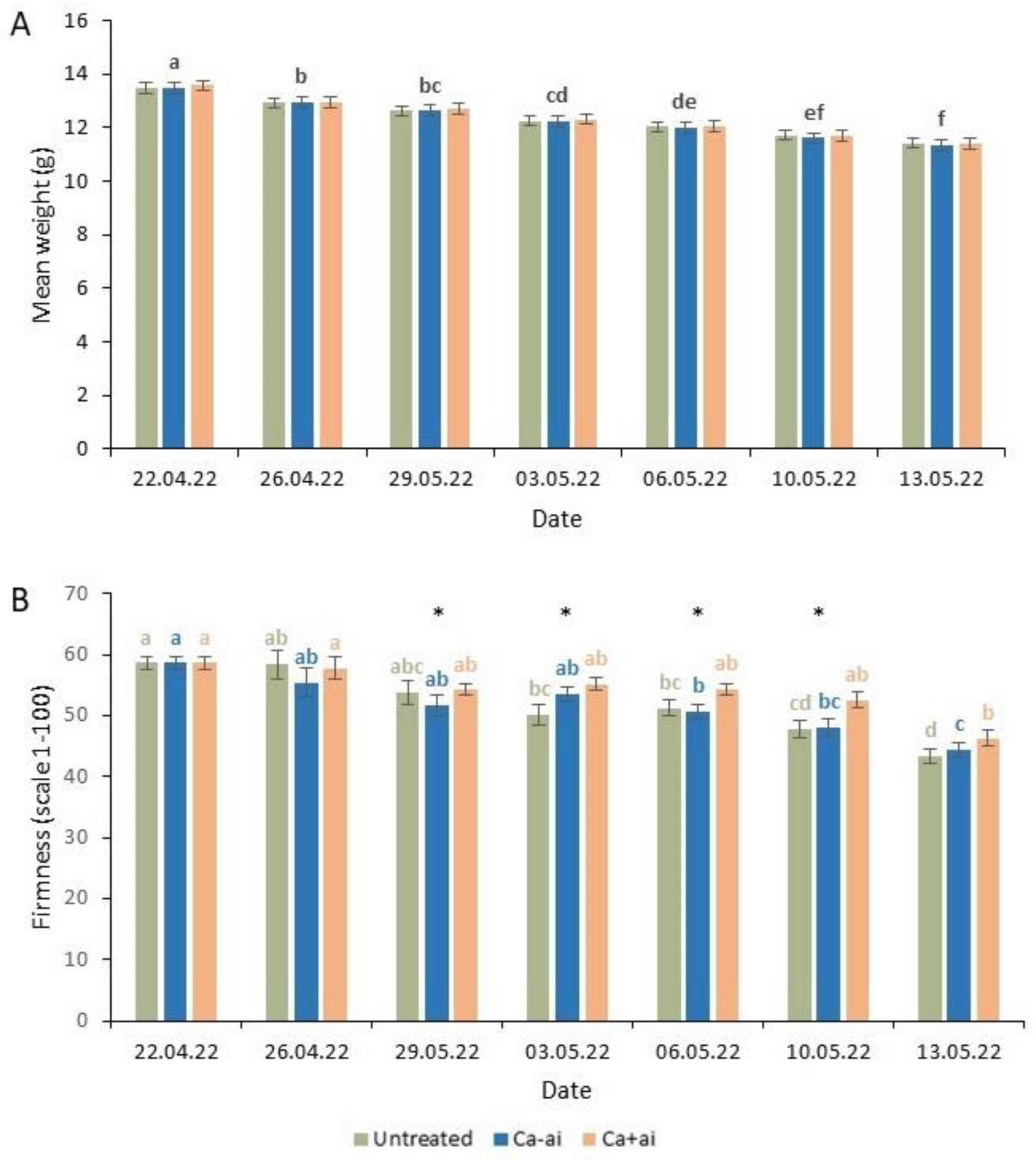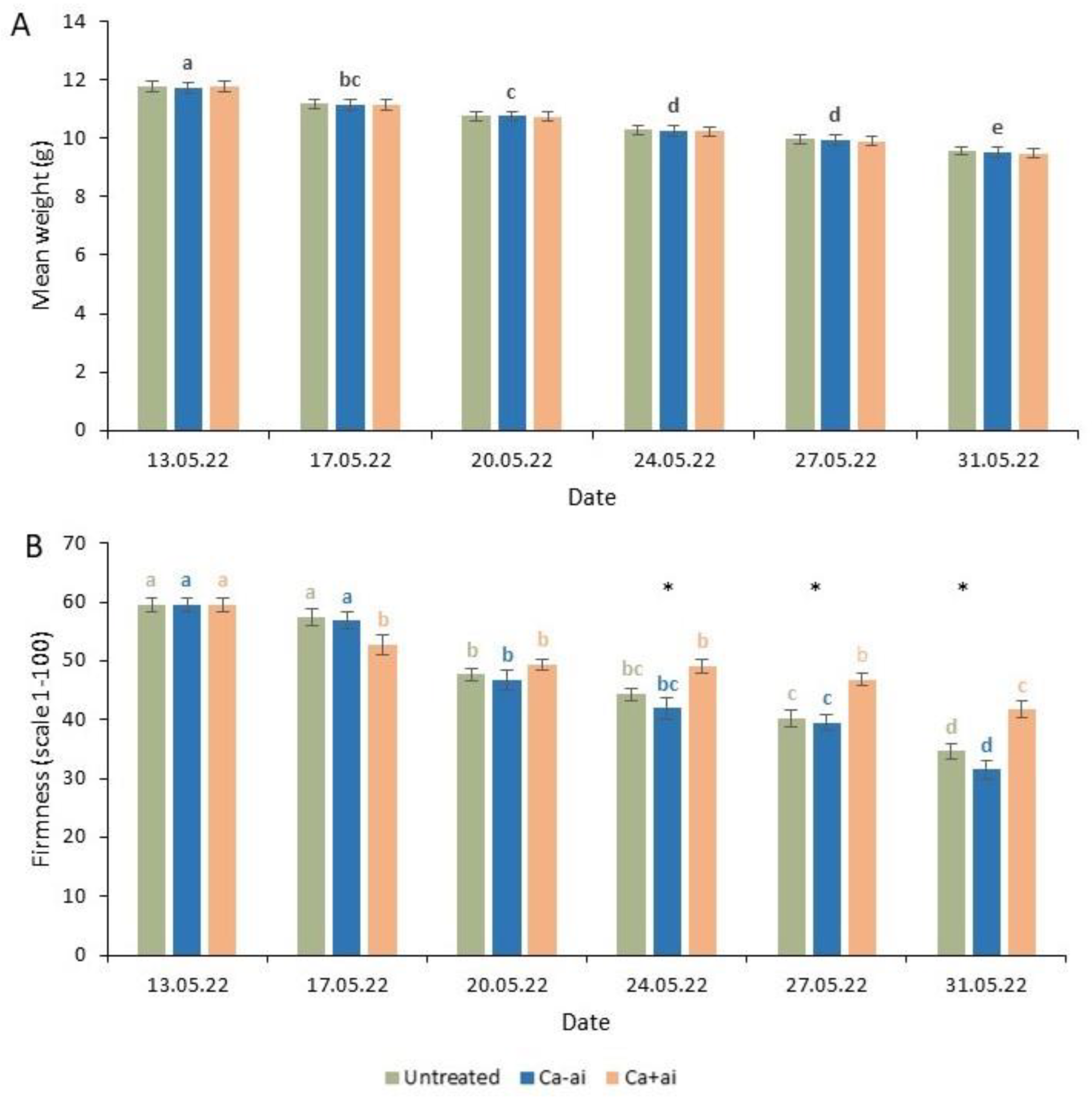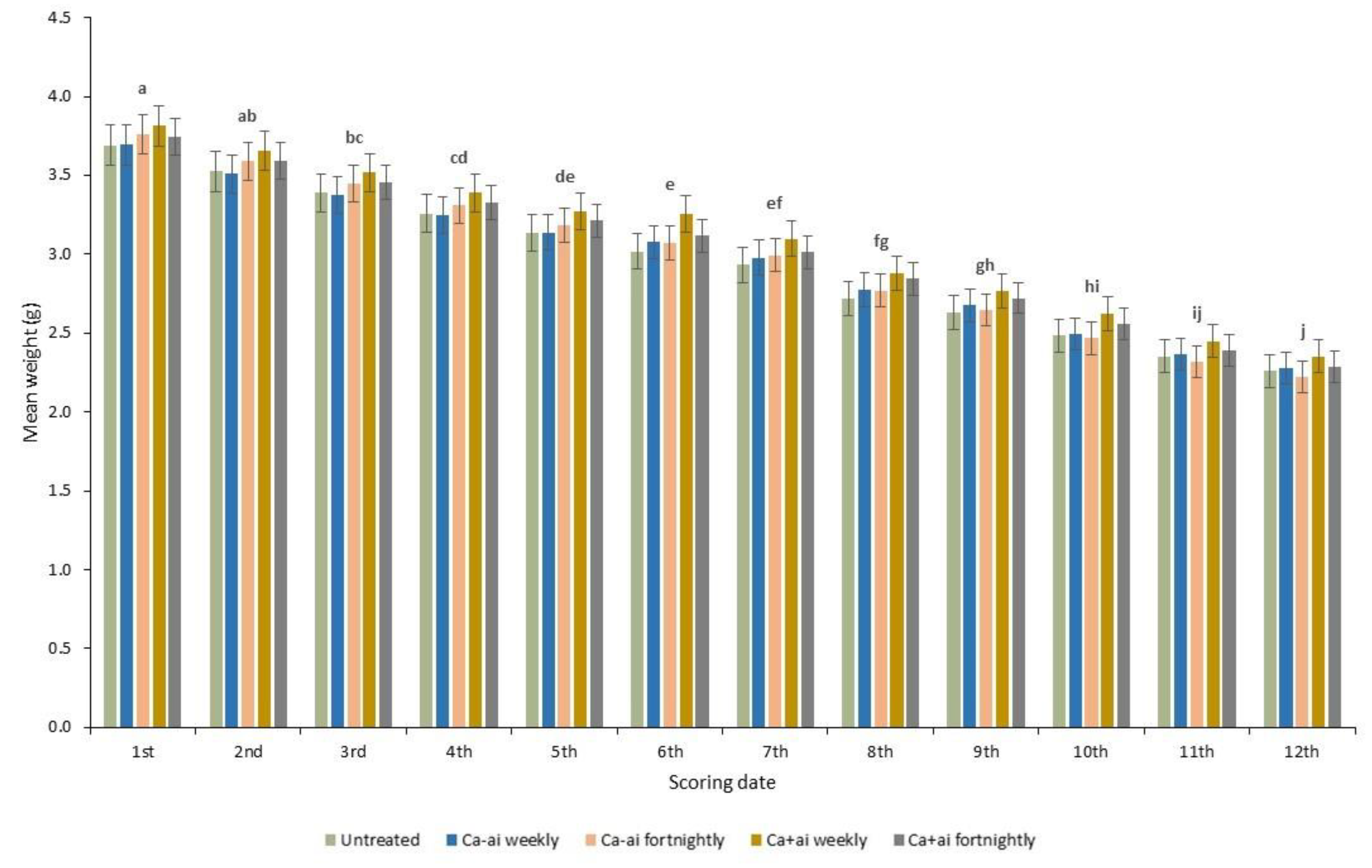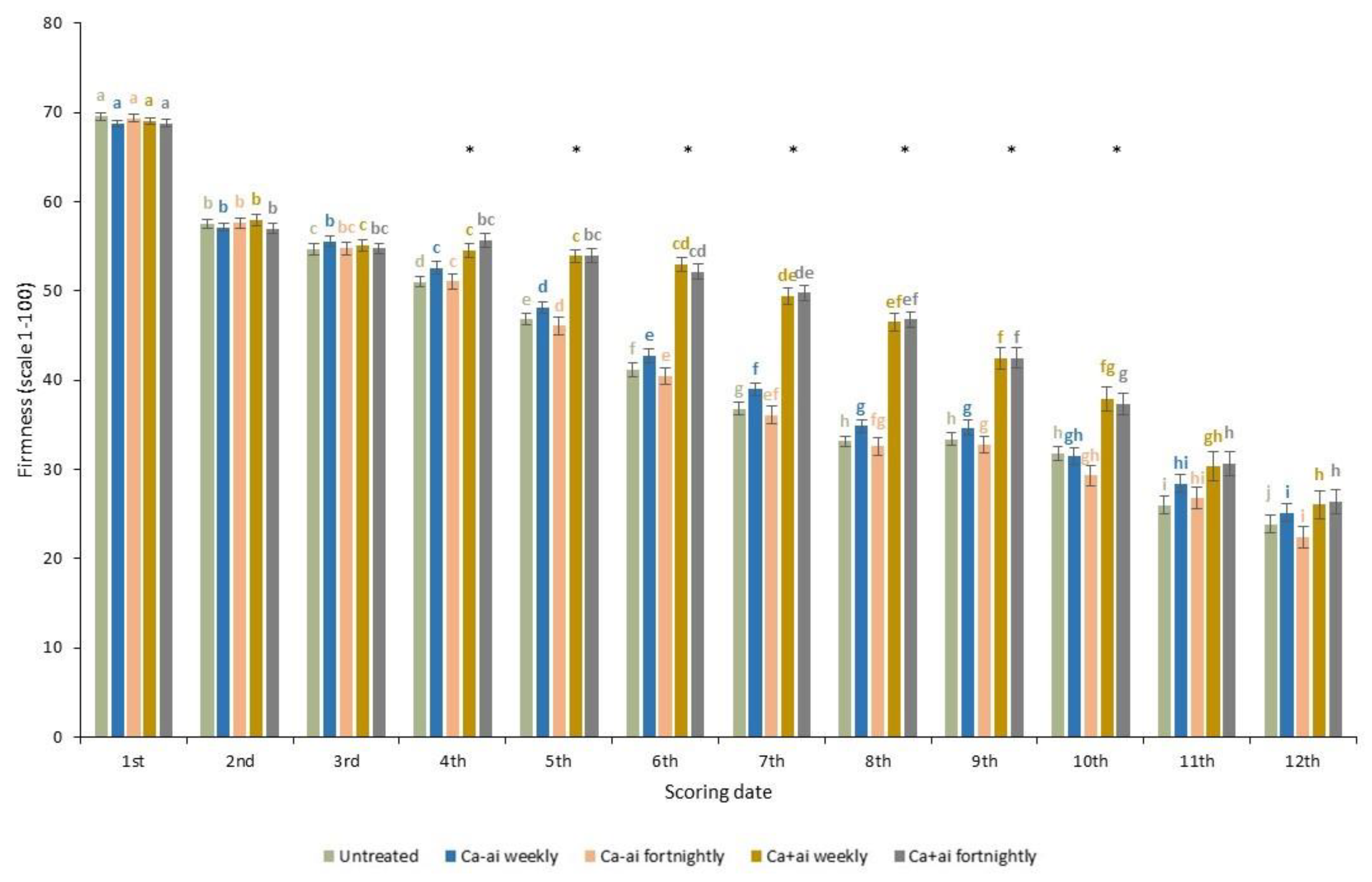1. Introduction
Tomato (
Solanum lycopersicum L.) is a key vegetable for human consumption that has beneficial impacts due to its nutritional composition containing carbohydrates, protein and vitamins as well as its anti-oxidant, anti-inflammatory and anticancer effects [
1]. In 2021, global tomato production covered 5,167,388 ha with a yield of almost 190 million tonnes [
2]. Tomatoes are climacteric fruit, meaning they can be harvested before they are at the fully ripe stage and they will continue to ripen until the colour is red, but they deteriorate rapidly after harvest [
3]. Harvested tomatoes are susceptible to damage postharvest as they are soft and much damage is caused by handling during transport and storage [
4]. In developing countries, the storage, transport and packing of horticultural crops postharvest can cause 50 % losses [
5]. Fruit firmness is a key trait that enables transport and storage of tomatoes as harder fruit will be able to better resist damage [
6], as too much softening of fruit postharvest is the main factor impacting the shelf-life and reducing it [
7]. When considering food supply chains for tomatoes and their environmental impacts, wastage accounted for up to 33% of their contribution to climate change [
8], so being able to produce fruit that is firmer and better able to withstand post-harvest handling, will therefore reduce wastage and it could have a significant impact on tomatoes’ environmental impact.
Calcium has been shown to be a key nutrient for development and growth of plants as it is an essential nutrient that is also linked to cell wall strength and stability [
9,
10]. When calcium is present in cell walls, they have increased strength, which means the plant cells are able to better resist damage, especially in fruit that can become damaged once it has been harvested and is being handled and stored under suboptimal conditions. Calcium is taken up via the roots and moved to the leaves and shoots in the xylem [
11]. This mass flow of the calcium bypasses the young leaves and fruits as it mainly moves to the established mature leaves, so calcium deficiencies are often found in the new leaves and fruit [
10]. Once the calcium has reached the mature tissue, there is only very limited remobilization of it to the young leaves and fruits via the phloem [
10].
Previous work has assessed the effects of calcium chloride (CaCl
2), chitosan, hydrogen peroxide and ozonated water on the firmness of tomatoes linked to their quality and storage ability with chitosan and calcium chloride being the best treatments when applied post-harvest [
3]. Other work has also shown that foliar calcium application resulted in better growth, yield and quality of four tomato cultivars, thereby indicating that good nutrition with essential nutrients will increase tomato production [
12]. Postharvest application of 2 % (w/v) calcium lactate in distilled water could maintain the quality of tomato fruit when an ultrasound treatment was also used for between 15 to 40 min [
13]. Postharvest dipping of tomato fruit in 0, 2 and 6 % CaCl
2 for between 10 to 30 min was shown to increase fruit firmness under the 6 % treatment for 20 and 30 min (Arthur et al., 2015). Additionally, it has been shown that foliar application of calcium before harvest can also affect the postharvest physiology of tomatoes. When tomato plants were treated with foliar applications of CaCl
2 at 10 kg ha
-1 16, 8 and 3 d before harvest, it resulted in the fruit firmness being maintained at a higher level than in the untreated plants [
15]. Other work assessed the source of calcium with calcium sulphate, calcium nitrate, calcium silicate, poultry manure and pressmud (sugarcane processing waste product) being used at application rates up to 80 kg ha
-1 calcium. Poultry manure resulted in the greatest fruit firmness after harvest with the calcium sulphate, calcium nitrate and calcium silicate all resulting in similar firmness levels [
16].
The previous work has shown that calcium application in a range of forms and at different times can improve the post-harvest firmness and shelf-life, but the application rates are high, which is due to the way that calcium is transported through the plant and that it does not normally travel to fruits during their development, so large applications are needed to get enough calcium to the fruit. Previously, calcium transport stimulants (MCAS) have been developed that stimulate calcium transport into plant cells, as auxins do, but without the effect of being a plant growth hormone [
17]. In strawberry, MCAS have been used to increase the fruit firmness and post-harvest shelf-life while applying one third of the amount of calcium as in the industry standard application [
18], while in apple it has reduced bitter pit, a disorder related to poor calcium transport [
17].
This work aimed to assess the applicability of using calcium with an MCAS (Albina containing LoCal, Levity Crop Science, UK) to increase the post-harvest firmness of tomato. To do this calcium with and without the MCAS was applied to harvested fruit in the laboratory and to tomato plants in a glasshouse. The successful use of calcium and an MCAS to tomato would benefit growers by reducing the amount of calcium they would need to apply and increasing their saleable yields as the fruit would have better post-harvest characteristics and shelf-life.
2. Materials and Methods
The work consisted of three separate experiments to show the impact of calcium applied with the MCAS vs. calcium applied without the MCAS, referred to as Ca+ai (active ingredient, the MCAS) and Ca-ai, respectively. Both the Ca+ai and Ca-ai treatments were identical apart from whether the MCAS had or had not been added.
2.1. Application to harvested tomatoes
Cherry tomatoes were purchased from a supermarket in the UK. Several punnets of cherry tomatoes were used in each repeat of the experiment, and for each repeat they were selected to be the same variety, have the same best before date and to have come from the same supplier and were all purchased on the same day. All the cherry tomatoes were mixed and fruit with similar weights were used.
There were three treatments: untreated, misted with 5 % Ca-ai and misted with 5 % Ca+ai applied once at the start of the experiment. For each repeat, 40 fruit were used for each treatment. To mist the 40 fruit in each of the Ca-ai and Ca+ai treatments, 5 ml of the 5 % treatments were applied to each, and each treatment contained 0.5 g of calcium. A further 40 fruit had their weight and firmness tested on the day the experiment was set up to give initial values. The untreated, Ca-ai and Ca+ai treated fruit had their weight and firmness recorded every three or four days for up to five times or until there were no differences between the treatments.
Firmness was recorded using a non-destructive penetrometer, Durofel (CTIFL Copa Technologie, Saint Etienne du Gr` es, France) with a bolt of 3 mm diameter (0.10 cm2). Each cherry tomato had its firmness recorded twice and an average was taken to give the firmness for each sampling date.
The experiment was repeated three times.
2.2. Application to tomato plants before harvest
Microtom tomato (Solanum lycopersicum) seeds were sown in plug trays filled with Sinclair’s reduced peat compost and transplanted to 2 L pots containing the same compost at the four leaf stage and grown in an experimental glasshouse located in Lancashire, UK. Plants were watered three times a week, or as required to maintain pot moisture. An industry standard complete fertilizer was applied at the label rate every three weeks. At flower set the plants were foliarly treated with Ca-ai or Ca+ai every 7 or 14 days at 1 L ha-1 in 200 L ha-1 water, or untreated. The weekly treatments were applied nine times and the fortnightly were applied five times. When applying the Ca-ai or Ca+ai treatments at 1 L ha-1, each application contained 181 g of calcium, so the weekly applications gave 1.6 kg ha-1 of calcium and the fortnightly treatments gave 0.91 kg ha-1 of calcium. In total 50 plants were used: 10 for each of the five treatments.
As fruit became ripe it was harvested six times over a one month period. All harvested fruit was then kept at room temperature and scored for weight and fruit firmness weekly for 12 weeks following harvest.
Firmness was recorded using the same method as in
Section 2.1.
2.3. Application to harvested tomatoes to mitigate handling damage
The method followed that in
Section 2.1 closely for obtaining the fruit and measurement of the weight and firmness.
The fruit was treated to simulate it being dropped a moderate distance during harvest and handling. For this we estimated that a cherry tomato would weight up to 18 g and if it was dropped a distance of 0.3 m, it would experience an impact force of 0.053 J. Therefore, to ensure repeatability, the fruit was positioned on a bench and an 11 g spherical hard object was dropped from a height of 0.5 m giving an impact force of 0.054 J. The fruit was kept stationary so that the impact point could be the same on all fruit, rather than the fruit being dropped.
The treatments were undropped and untreated; dropped and untreated; dropped and treated with 5 % Ca-ai mist; and dropped and treated with 5 % Ca-ai mist applied once at the start of the experiment. As in
Section 2.1, each treatment gave an application of 0.5 g calcium.
2.4. Statistical analysis
Statistical analysis was undertaken using the Jamovi 1.6.23 for Windows software [
19] using the p<0.05 significance level.
4. Discussion
In plants, calcium is generally transported from the roots to the new leaves, and it bypasses the developing and ripening fruit [
10], despite it being a key element for cell wall strength in fruit [
9] that is needed for increased post-harvest robustness. Previous work has shown that the use of an MCAS and calcium can reduce calcium related fruit disorders in apple [
17] and increase the firmness of strawberries [
18]. In this work we assessed the application of calcium with and without the addition of an MCAS to tomatoes in the laboratory and glasshouse.
In the first part of this work, already harvested and ripe tomatoes were obtained from a supermarket in the United Kingdom and had calcium with and without the addition of the MCAS active ingredient misted onto their surface for 1 min and kept in a laboratory at room temperature. All three repeats of the experiment gave very similar results with the Ca+ai giving significantly firmer fruit (
Figure 1B,
Figure 2B and
Figure 3B). In all repeats, initially all the fruit had similar firmness values for the second and third (second and third repeats only) scoring dates but from the third (first repat only) and fourth scoring dates the Ca+ ai treatment gave fruit that were significantly firmer than the untreated or Ca-ai treated fruit. Additionally, in the first and third repeats the Ca+ai treated fruit maintained its starting firmness until scoring date four while the untreated or Ca-ai treated fruit only maintained their starting firmness until scoring date two. In the second repeat, the Ca+ai treated fruits’ firmness initially reduced but maintained this level for three scoring dates compared to just two scoring dates for the other two treatments. The firmness of the harvested and ripe fruit, when kept at room temperature, was maintained for between 10 to 18 d when treated with Ca+ai compared to between three and 11 d for the untreated or Ca-ai treatments. This shows that the Ca+ai treatment was able to significantly improve the firmness of harvested and ripe fruit; the addition of the MCAS to calcium meant that it had impacts on the fruit that were not shown by just the calcium treatment without the MCAS added. This effect on the fruit was achieved by misting just 5 ml of the 5 % product that contained only 0.5 g of calcium that was left on the fruit for only 1 min.
Previous work has shown mixed results from the post-harvest application of calcium to increase tomato firmness and therefore increase the shelf-life. Calcium chloride (1 %) was able to slow the rate at which the firmness reduced for fruit stored at 10
oC for up to 28 d with two days at room temperature, but the starting firmness of the untreated tomatoes was quite a bit less than that of the calcium treated tomatoes [
3]. In that work the fruit was immersed in the 1 % calcium chloride solution for 5 min, which could slow the harvesting and processing of the fruit much more than just misting the fruit, as was used in the current work. Another study used cherry tomatoes, as in this work, and a 2 % calcium lactate treatment, but the treatment step involved using a sonicator at ultrasound energy densities of between 16 and 36 W L
-1 at temperatures of between 15 and 35
oC for between 5 to 40 min, for washing the cherry tomatoes in the calcium treatment [
13]. The firmness was maintained when the energy density was 20 W L
-1 at 15
oC for 15 min. The ultrasound significantly increased the calcium content in the treated fruit, so the authors concluded that ultrasound and calcium lactate could be a suitable method for maintaining cherry tomato texture, but this seems quite an involved process compared to using an MCAS to increase the firmness of cherry tomatoes, as shown in the present study. Another study used a dipping method for the treatment of post-harvest fruit where 0, 2 and 6 % calcium chloride solutions were used for dipping fruit for 10, 20 and 30 min, with the 6 % solution at 20 and 30 min giving significantly higher firmness levels for up to 12 d (Arthur et al., 2015). This study again used calcium to increase the firmness of tomatoes, but the application method would not be suitable for commercial application as the fruit would need to be washed for up to 30 min and a 6 % solution is needed, while in the current study misting for only 1 min was used with 0.5 g of calcium applied. In a further study, tomatoes were treated in a hot water bath (40 or 50
oC) for two minutes before two minutes in a 2 % calcium chloride solution, and storage at 10
oC for up to 14 d, which again showed that the loss of firmness could be controlled by calcium [
20]. Again, this is a more complex treatment method that the one used in the current work. Another study dipped harvested tomatoes in 4, 8 and 12 % calcium chloride solutions for 10 min, with the 8 % treatment giving the best result of the lowest loss of physicochemical characteristics [
21]. This first application of calcium with MCAS to cherry tomatoes in the laboratory in the current study has shown that it can increase the firmness of the fruit while requiring a much simpler application method and small amount of calcium.
Once the initial laboratory work had shown that Ca+ai could increase the firmness in harvested fruit via misting, a glasshouse trial was conducted to assess the application of the Ca+ai foliarly and its impact on post-harvest firmness and shelf-life. Microtom tomatoes were grown in a glasshouse and were either untreated or had Ca-ai or Ca+ai applied either weekly or fortnightly. For both the Ca-ai and the Ca+ai treatments, there were no differences between the weekly or fortnightly applications (
Figure 5), which shows that the reduced application schedule would be suitable, thereby saving growers the time and money involved with more frequent applications. For all treatments, the firmness decreased from harvest to the second scoring date (one week later), and this firmness level was maintained into week three, but following this the Ca+ai treatment gave significantly firmer fruit than the untreated or Ca-ai from week four until week 10. The firmness level from week three was maintained until week six for the Ca+ai treatment compared to it only being maintained until week four in the other treatments. This was in fruit that were stored at room temperature, so shelf-life and firmness could be maintained for even longer if cold storge was used. The application rate was 1 L ha
-1 of product per application, which contained 181.2 g calcium per application. There were five applications for the fortnightly treatment schedule, so 0.91 kg ha
-1 of calcium with the MCAS was applied to give the significantly firmer fruit in this work.
Previous work assessing the effect of foliar applications of calcium to fruit firmness has found that the firmness can be impacted. For example, 0.5, 1 and 1.5 % calcium chloride concentrations were applied foliarly twice over the growing season with the fruit firmness increasing as the calcium concentration increased with the 1.5 % concentration giving the greatest fruit firmness [
12]. The application rate for the 1.5 % calcium chloride treatment is not give in the work, but if it had been applied at 200 L ha
-1, as in the current study, that would have been 2.46 kg ha
-1 calcium per application, so the two applications would apply 4.92 kg ha
-1 calcium. While the current work only applied 0.91 kg ha
-1 calcium, which could maintain the firmness when applied with an MCAS. Another study looked at different calcium sources (calcium sulphate, calcium nitrate, calcium silicate, poultry manure and pressmud), which were all applied at rates up to 80 kg ha
-1 calcium [
16]. Their findings showed that the highest fruit firmness over 15 d monitoring post-harvest was obtained from the 80 kg ha
-1 calcium as poultry manure. Compared to the poultry manure, the calcium sulphate, calcium nitrate and calcium silicate all gave quite similar but lower firmness values for each application rate. In this work, the lowest rate tested, of 20 kg ha
-1 calcium, which was much higher than the 0.91 kg ha
-1 calcium used in the current work. In an alternative piece of work calcium chloride was applied foliarly at 10 kg ha
-1 three times before harvest and compared to untreated plants [
15], and the calcium treatment resulted in firmer fruit than the untreated for up to 21 d after harvest when kept at 12
oC. This improvement in the firmness from the calcium treatment was obtained by applying 30 kg ha
-1, which is more than the 0.91 kg ha
-1 applied in the current study. The current work has replicated the previous results and increased the post-harvest firmness of tomatoes that were treated foliarly with calcium before harvest, but when using as much lower application rate of calcium with MCAS.
Finally, we assessed that ability of calcium with MCAS to prevent or reduce the damage from post-harvest bruising and improper handling. Tomatoes are a soft fruit that deteriorates quickly after harvest [
3], especially due to handling during the transport of the fruit [
4], and there can be losses of up to 50 % in developing countries [
5]. Calcium application post-harvest to tomatoes has been shown to be critical for maintaining the quality [
22]. Impact damage occurs to tomatoes during harvest, handling and processing [
23]. To do this, we obtained harvested and ripe cherry tomatoes from a UK supermarket and simulated them being dropped 0.3 m. This was done by keeping the tomato stationary and dropping a hard object it onto it, so the impact force (0.054 J) was equivalent to a 0.3 m drop for an 18 g cherry tomato. Forces of 0.125 to 0.5 J have been used to simulate bruising and handling damage, for bruise modelling, to larger tomatoes previously [
23], so the force used in this work was in line with pervious values used when considering the size of the tomato. In the first repeat, on the second and third scoring dates the dropped tomatoes treated with Ca+ai had the same firmness as tomatoes that had not been dropped or treated, while the dropped and untreated or dropped and treated with Ca-ai had significantly lower firmness values, while on scoring dates five and six, the Ca+ai treated fruit were firmer than all the other fruit. Through out this experiment, the firmness of the Ca+ai treated tomatoes was not significantly different from the initial firmness (
Figure 6). In the second repeat, on scoring date three the undropped and untreated tomatoes were the same as the dropped and Ca+ai treated fruit with both being significantly firmer than the dropped and untreated or the dropped and Ca-ai treated, while on scoring dates four and five the dropped and Ca+ai treated fruit were firmer than the fruit from all other treatments (
Figure 7). This shows that misting with 5 ml of product containing 0.5 g calcium could prevent the fruit softening that comes from damage during harvest and transport of tomatoes.
Calcium treatments have been shown to reduce and prevent bruises and damage, from handling, developing post-harvest in apples [
24] and lemons [
25]. In tomato, when the fruit is diced for consumption either raw or canned, a calcium treatment has been shown to increase the firmness and ability to resist mechanical abuse [
26]. In that work a 600 mg L
-1 calcium chloride solution was used to dip the tomato dices for 5 mins at 24
oC either before or after the mechanical abuse. All samples exposed to calcium were firmer than the untreated samples, and there was no difference in the firmness between treatment before or after mechanical abuse. The current work supports this as we have found that postharvest treatment with calcium and MCAS can reduce and prevent postharvest damage in whole fruit, which will be very valuable knowledge for growers who face significant losses from postharvest handling and transport due to damaged fruit.
In all the experiments presented here there were no significant differences between the weights of the tomatoes for any of the treatments (
Figure 1A,
Figure 2A,
Figure 3A,
Figure 4,
Figure 6A and
Figure 7A). The weights decreased over time, but by a similar amount for all the tomatoes in each of the treatment groups. The treatment with calcium and MCAS did not impact weight loss in the current work.
Figure 1.
Mean weight (g) (A) and firmness (unitless scale of 0 soft to 100 hard) (B) for first repeat of experiment for cherry tomatoes brought from a UK supermarket for untreated, misted with 5 % Ca-ai (active ingredient – MCAS) or misted with 5 % Ca+ai treated once on first scoring date. (A) There were no significant differences between treatments for each sample date, and lowercase letters indicate significant differences between combined weights for scoring dates (ANOVA (non-parametric) followed by Dwass-Steel-Critchlow-Fligner pairwise comparisons, P<0.05). (B) Lowercase letters above bars for each treatment indicate significant differences between scoring dates for that treatment (ANOVA followed by independent sample t-tests, P<0.05). * indicates significant differences between the Ca+ai and the other two treatments for that sampling date (ANOVA followed by independent sample t-tests, P<0.05).
Figure 1.
Mean weight (g) (A) and firmness (unitless scale of 0 soft to 100 hard) (B) for first repeat of experiment for cherry tomatoes brought from a UK supermarket for untreated, misted with 5 % Ca-ai (active ingredient – MCAS) or misted with 5 % Ca+ai treated once on first scoring date. (A) There were no significant differences between treatments for each sample date, and lowercase letters indicate significant differences between combined weights for scoring dates (ANOVA (non-parametric) followed by Dwass-Steel-Critchlow-Fligner pairwise comparisons, P<0.05). (B) Lowercase letters above bars for each treatment indicate significant differences between scoring dates for that treatment (ANOVA followed by independent sample t-tests, P<0.05). * indicates significant differences between the Ca+ai and the other two treatments for that sampling date (ANOVA followed by independent sample t-tests, P<0.05).
Figure 2.
Mean weight (g) (A) and firmness (unitless scale of 0 soft to 100 hard) (B) for second repeat of experiment for cherry tomatoes brought from a UK supermarket for untreated, misted with 5 % Ca-ai (active ingredient – MCAS) or misted with 5 % Ca+ai treated once on first scoring date. (A) There were no significant differences between treatments for each sample date, and lowercase letters indicate significant differences between combined weights for scoring dates (ANOVA (non-parametric) followed by Dwass-Steel-Critchlow-Fligner pairwise comparisons, P<0.05). (B) Lowercase letters above bars for each treatment indicate significant differences between scoring dates for that treatment (ANOVA followed by independent sample t-tests, P<0.05). * indicates significant differences between the Ca+ai and the other two treatments for that sampling date (ANOVA followed by independent sample t-tests, P<0.05).
Figure 2.
Mean weight (g) (A) and firmness (unitless scale of 0 soft to 100 hard) (B) for second repeat of experiment for cherry tomatoes brought from a UK supermarket for untreated, misted with 5 % Ca-ai (active ingredient – MCAS) or misted with 5 % Ca+ai treated once on first scoring date. (A) There were no significant differences between treatments for each sample date, and lowercase letters indicate significant differences between combined weights for scoring dates (ANOVA (non-parametric) followed by Dwass-Steel-Critchlow-Fligner pairwise comparisons, P<0.05). (B) Lowercase letters above bars for each treatment indicate significant differences between scoring dates for that treatment (ANOVA followed by independent sample t-tests, P<0.05). * indicates significant differences between the Ca+ai and the other two treatments for that sampling date (ANOVA followed by independent sample t-tests, P<0.05).
Figure 3.
Mean weight (g) (A) and firmness (unitless scale of 0 soft to 100 hard) (B) for third repeat of experiment for cherry tomatoes brought from a UK supermarket for untreated, misted with 5 % Ca-ai (active ingredient – MCAS) or misted with 5 % Ca+ai treated once on first scoring date. (A) There were no significant differences between treatments for each sample date, and lowercase letters indicate significant differences between combined weights for scoring dates (ANOVA (non-parametric) followed by Dwass-Steel-Critchlow-Fligner pairwise comparisons, P<0.05). (B) Lowercase letters above bars for each treatment indicate significant differences between scoring dates for that treatment (ANOVA followed by independent sample t-tests, P<0.05). * indicates significant differences between the Ca+ai and the other two treatments for that sampling date (ANOVA followed by independent sample t-tests, P<0.05).
Figure 3.
Mean weight (g) (A) and firmness (unitless scale of 0 soft to 100 hard) (B) for third repeat of experiment for cherry tomatoes brought from a UK supermarket for untreated, misted with 5 % Ca-ai (active ingredient – MCAS) or misted with 5 % Ca+ai treated once on first scoring date. (A) There were no significant differences between treatments for each sample date, and lowercase letters indicate significant differences between combined weights for scoring dates (ANOVA (non-parametric) followed by Dwass-Steel-Critchlow-Fligner pairwise comparisons, P<0.05). (B) Lowercase letters above bars for each treatment indicate significant differences between scoring dates for that treatment (ANOVA followed by independent sample t-tests, P<0.05). * indicates significant differences between the Ca+ai and the other two treatments for that sampling date (ANOVA followed by independent sample t-tests, P<0.05).
Figure 4.
Mean weight (g) for 12 weeks post-harvest for fruit harvested from microtom tomato (Solanum lycopersicum) grown in a glasshouse for untreated or foliarly sprayed with Ca-ai (active ingredient – MCAS) or Ca+ai either weekly or fortnightly at 1 L ha-1 in 200 L ha-1 water. There were no significant differences between treatments for each scoring date (ANOVA), and lowercase letters indicate significant differences between combined weights for scoring dates (ANOVA (non-parametric) followed by Dwass-Steel-Critchlow-Fligner pairwise comparisons, P<0.05).
Figure 4.
Mean weight (g) for 12 weeks post-harvest for fruit harvested from microtom tomato (Solanum lycopersicum) grown in a glasshouse for untreated or foliarly sprayed with Ca-ai (active ingredient – MCAS) or Ca+ai either weekly or fortnightly at 1 L ha-1 in 200 L ha-1 water. There were no significant differences between treatments for each scoring date (ANOVA), and lowercase letters indicate significant differences between combined weights for scoring dates (ANOVA (non-parametric) followed by Dwass-Steel-Critchlow-Fligner pairwise comparisons, P<0.05).
Figure 5.
Firmness (unitless scale of 0 soft to 100 hard) for 12 weeks post-harvest for fruit harvested from microtom tomato (Solanum lycopersicum) grown in a glasshouse for untreated or foliarly sprayed with Ca-ai (active ingredient – MCAS) or Ca+ai either weekly or fortnightly at 1 L ha-1 in 200 L ha-1 water. Lowercase letters above bars for each treatment indicate significant differences between scoring dates for that treatment (ANOVA followed by independent sample t-tests, P<0.05). * indicates significant differences between the Ca+ai weekly and fortnightly treatments and the other three treatments for that scoring date (ANOVA followed by independent sample t-tests, P<0.05).
Figure 5.
Firmness (unitless scale of 0 soft to 100 hard) for 12 weeks post-harvest for fruit harvested from microtom tomato (Solanum lycopersicum) grown in a glasshouse for untreated or foliarly sprayed with Ca-ai (active ingredient – MCAS) or Ca+ai either weekly or fortnightly at 1 L ha-1 in 200 L ha-1 water. Lowercase letters above bars for each treatment indicate significant differences between scoring dates for that treatment (ANOVA followed by independent sample t-tests, P<0.05). * indicates significant differences between the Ca+ai weekly and fortnightly treatments and the other three treatments for that scoring date (ANOVA followed by independent sample t-tests, P<0.05).
Figure 6.
Mean weight (g) (A) and firmness (unitless scale of 0 soft to 100 hard) (B) for first repeat of experiment for cherry tomatoes brought from a UK supermarket for undropped and untreated (undropped), dropped and untreated (dropped), dropped and misted with 5 % Ca-ai (active ingredient – MCAS) (dropped Ca-ai) or dropped and misted with 5 % Ca+ai (dropped Ca+ai) treated once on first scoring date. (A) There were no significant differences between treatments for each sample date, and lowercase letters indicate significant differences between combined weights for scoring dates (ANOVA (non-parametric) followed by Dwass-Steel-Critchlow-Fligner pairwise comparisons, P<0.05). (B) Lowercase letters above bars for each treatment indicate significant differences between scoring dates for that treatment (ANOVA followed by independent sample t-tests, P<0.05). ~ indicates significant difference between dropped Ca+ai and dropped Ca-ai treatment, ^ indicates significant difference between dropped Ca+ai and dropped with dropped Ca-ai treatments and * indicates significant differences between the dropped Ca+ai and the other three treatments, for that sampling date (ANOVA followed by independent sample t-tests, P<0.05).
Figure 6.
Mean weight (g) (A) and firmness (unitless scale of 0 soft to 100 hard) (B) for first repeat of experiment for cherry tomatoes brought from a UK supermarket for undropped and untreated (undropped), dropped and untreated (dropped), dropped and misted with 5 % Ca-ai (active ingredient – MCAS) (dropped Ca-ai) or dropped and misted with 5 % Ca+ai (dropped Ca+ai) treated once on first scoring date. (A) There were no significant differences between treatments for each sample date, and lowercase letters indicate significant differences between combined weights for scoring dates (ANOVA (non-parametric) followed by Dwass-Steel-Critchlow-Fligner pairwise comparisons, P<0.05). (B) Lowercase letters above bars for each treatment indicate significant differences between scoring dates for that treatment (ANOVA followed by independent sample t-tests, P<0.05). ~ indicates significant difference between dropped Ca+ai and dropped Ca-ai treatment, ^ indicates significant difference between dropped Ca+ai and dropped with dropped Ca-ai treatments and * indicates significant differences between the dropped Ca+ai and the other three treatments, for that sampling date (ANOVA followed by independent sample t-tests, P<0.05).
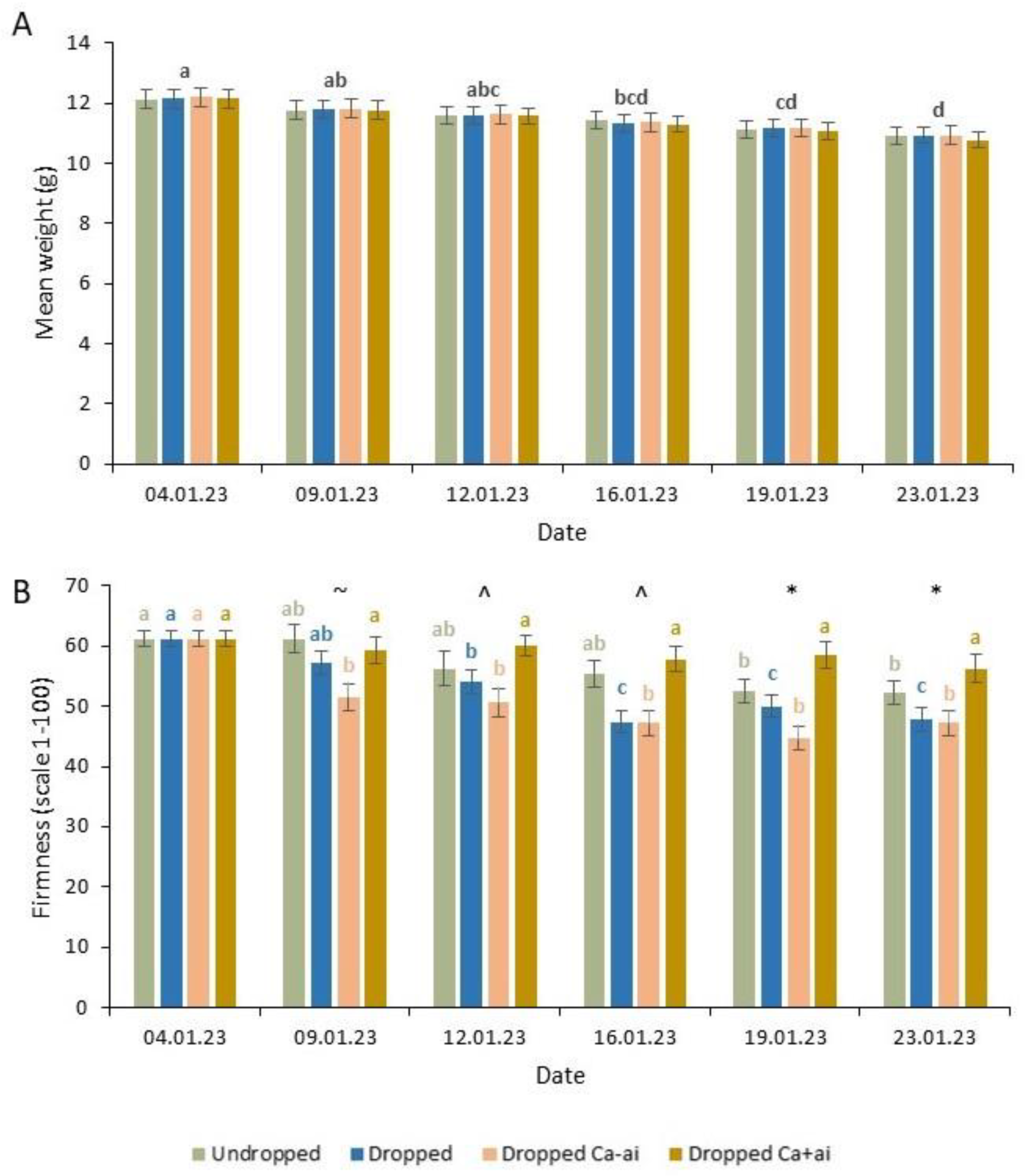
Figure 7.
Mean weight (g) (A) and firmness (unitless scale of 0 soft to 100 hard) (B) for second repeat of experiment for cherry tomatoes brought from a UK supermarket for undropped and untreated (undropped), dropped and untreated (dropped), dropped and misted with 5 % Ca-ai (active ingredient – MCAS) (dropped Ca-ai) or dropped and misted with 5 % Ca+ai (dropped Ca+ai) treated once on first scoring date. (A) There were no significant differences between treatments for each sample date, and lowercase letters indicate significant differences between combined weights for scoring dates (ANOVA (non-parametric) followed by Dwass-Steel-Critchlow-Fligner pairwise comparisons, P<0.05). (B) Lowercase letters above bars for each treatment indicate significant differences between scoring dates for that treatment (ANOVA followed by independent sample t-tests, P<0.05). ~ indicates significant difference between dropped Ca+ai and dropped Ca-ai treatment, ^ indicates significant difference between dropped Ca+ai and dropped with dropped Ca-ai treatments and * indicates significant differences between the dropped Ca+ai and the other three treatments, for that sampling date (ANOVA followed by independent sample t-tests, P<0.05).
Figure 7.
Mean weight (g) (A) and firmness (unitless scale of 0 soft to 100 hard) (B) for second repeat of experiment for cherry tomatoes brought from a UK supermarket for undropped and untreated (undropped), dropped and untreated (dropped), dropped and misted with 5 % Ca-ai (active ingredient – MCAS) (dropped Ca-ai) or dropped and misted with 5 % Ca+ai (dropped Ca+ai) treated once on first scoring date. (A) There were no significant differences between treatments for each sample date, and lowercase letters indicate significant differences between combined weights for scoring dates (ANOVA (non-parametric) followed by Dwass-Steel-Critchlow-Fligner pairwise comparisons, P<0.05). (B) Lowercase letters above bars for each treatment indicate significant differences between scoring dates for that treatment (ANOVA followed by independent sample t-tests, P<0.05). ~ indicates significant difference between dropped Ca+ai and dropped Ca-ai treatment, ^ indicates significant difference between dropped Ca+ai and dropped with dropped Ca-ai treatments and * indicates significant differences between the dropped Ca+ai and the other three treatments, for that sampling date (ANOVA followed by independent sample t-tests, P<0.05).
